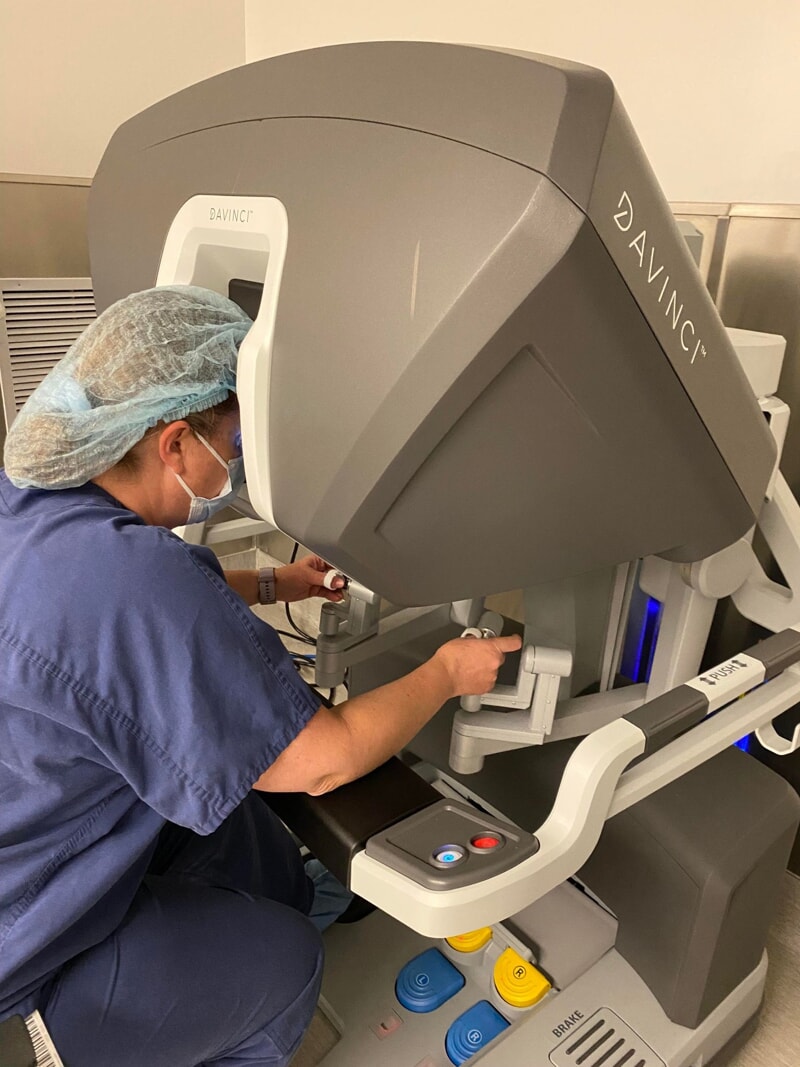
In August 2022, Dr. Willen performed the first robotic-assisted surgery at Carson Valley Health (CVH) using an exciting addition to the surgical services department —the da Vinci surgical system. This futuristic-looking machine is part of an ongoing effort to increase the number of healthcare services offered and improve the patient experience at CVH.
 What is robotic-assisted surgery?
What is robotic-assisted surgery?
If you find the idea of robotic surgery intimidating, you’re not alone! Many believe that a robot operating on a human sounds like something out of a science fiction film. That’s because it is.
In robotic-assisted surgery, the robot doesn’t do the surgery — A human doctor does! The robot doesn’t make its own decisions about the surgery. Nor does it make any independent movements.
Instead, the da Vinci surgical system is a powerful tool that surgeons use to perform complex medical procedures with less pain and fewer risks.
In many ways, robotic-assisted surgery with the da Vinci surgical system is a lot like “regular” surgery. For example, along with the usual surgery team including nurses, an anesthesiologist, and techs, the surgeon remains in the operating room the entire time to monitor the patient closely.
There are some key differences, though. Instead of operating directly, the surgeon uses a computer to control small, robotic tools that carry out each step of the procedure — from the initial cut to the final stitches.
In addition, the scale of the surgery is different. During traditional (open) surgery, doctors must create a large cut, called an incision, to access the area of the body being worked on. By comparison, a typical incision with the da Vinci surgical system can range from eight to twelve millimeters. That’s about the size of your fingertip!
The surgeon sits at the console to carry out the surgery. This machine features built-in “tremor filtration technology” to ensure that every movement of the instruments is smooth and precise.
The console provides the surgeon a 10X magnified view of the area being worked on, also called the surgical field. This makes it much easier to view very fine details that may otherwise be difficult to detect with the human eye. For comparison, imagine looking at a quarter that’s the size of a dinner plate!
During the surgery, the patient is positioned near the patient cart. This
part of the da Vinci surgical system features 3-4 robotic arms, which
hold a tiny camera and an advanced set of surgical instruments. These
sturdy surgical instruments have an even greater range of motion than
a human wrist, which allows the surgeon to clamp, suture, and manipulate
tissue with remarkable accuracy.
Again, the robotic arms and instruments are designed to move only under
direct control by a surgeon. They won’t move on their own, even
if someone were to accidentally bump into the machine.
The da Vinci vision system includes a long, flexible tube with a camera and light at the tip. This combo streams live, high-definition, 3D video. The surgeon views this video at the console, while the rest of the surgical team observes the operation on a large monitor.
Around the world, the da Vinci has been used in over 7 million surgeries. This minimally invasive approach to surgery reduces the risk of potentially fatal surgical complications. Compared to traditional surgery, some patients who undergo robotic-assisted surgery may even experience:
Because incisions are smaller with da Vinci, scarring is minimal, too.
As you can see, the da Vinci is as multi-talented as its namesake. Regulatory agencies have approved the system for use in:
High-quality healthcare should be easily and affordably accessible for everyone. The addition of the da Vinci surgical system to the CVH surgical services department opens up new health horizons for our community.
As CVH’s director of perioperative services, Randall McElreath, RN, Ph.D explains, “da Vinci robotic-assisted surgery is the accepted standard of care for many specialties in more populated areas. The community ultimately has the choice on where to go for their surgical needs, and now for our Carson Valley patients, they have more opportunities to choose CVH.”
Our distinguished surgical team is proud to offer several robotic-assisted procedures to patients in Carson Valley and the surrounding areas.
To learn more about the da Vinci surgical system, please contact the CVH surgical services department at 775.782.1595 or watch this short video from Intuitive.























Tasty Ways to Make Sure You’re Staying Hydrated Spring is a season of renewal and rejuvenation, and what better way to welcome it than by indulging in ...
Continue Reading
Honor Donate Life Month This April April is Donate Life Month, a time when we celebrate the incredible gift of organ donation and encourage ...
Continue Reading.png)
Meet Leslie McGraw, Family Nurse Practitioner at Carson Valley Health Senior Care and Primary Care Virginia Ranch. You may have met her in-person ...
Continue Reading
GARDNERVILLE, Nev. – Born and raised in Carson Valley, Rhiannon Broersma, Physician Assistant Certified (PA-C), is joining the Urology team at Carson ...
Continue Reading
The Importance of Sunscreen Wearing sunscreen with an appropriate Sun Protection Factor (SPF) offers significant medical benefits that go beyond mere ...
Continue Reading
Holistic Ways to Improve Your Health In today's fast-paced world, the importance of mental well-being has never been more pronounced. As we navigate ...
Continue Reading
Carson Valley Health warmly welcomes Cindy Veal, APRN to its Urology medical staff at Ironwood Specialty Care. Veal, born and raised in Nevada, is ...
Continue Reading
Promoting Diagnostic Screenings The significance of regular cancer screenings cannot be overstated, as these screenings are vital tools in the early ...
Continue Reading